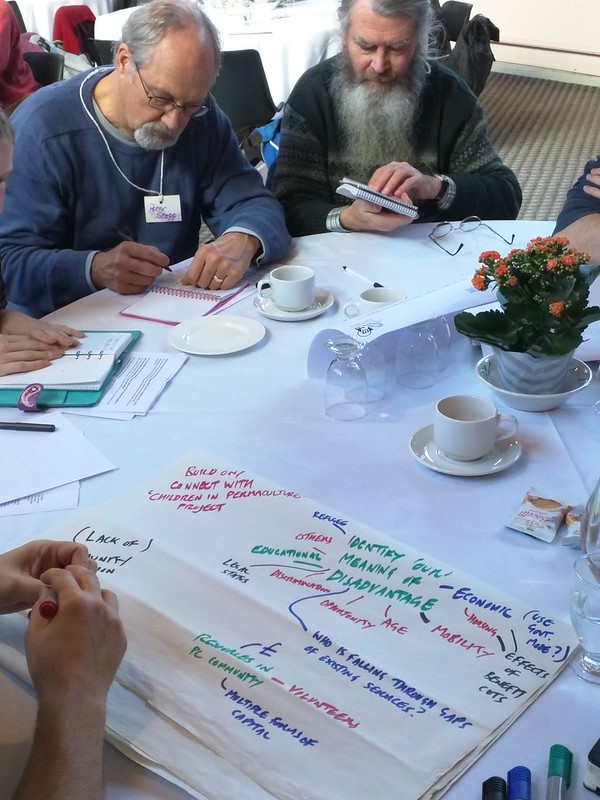by Peter Stopp
Permaculture Association member Peter Stopp shares his reflections on the day at Graceworks, 19 November 2016.
 Andy Goldring introduced the Friends of Permaculture scheme
Andy Goldring introduced the Friends of Permaculture scheme
‘Friends’ are people who wish simply to donate in support of the Permaculture Association. 50% of the donation will go to the Association, 50% into a pot for engaging with the disadvantaged, called ‘Thriving Communities Fund’.
Whist the scheme is now launched, this first year is to be spent exploring how best to engage with disadvantaged and much of the session was spent in small groups exploring that. Andy will assemble those first thoughts in a report in a few weeks time.
Out of the 12 workshop presentations I could attend 3. These were contrasting examples of community engagement in earth care-based projects.
1. Charlie Gray reported on Horton Community Farm & Grow Bradford (www.hcf.org.uk), a 2 acre LAND project in central Bradford, now 7 years old. Whilst successful in growing and selling produce; training and employing people and attracting volunteers, there are currently major issues with vandalism and the project is trying to reengage with the local community. Charlie was using the Design Visions approach to analysing the project.
2. Pete Tatham (and colleague) introduced us to Hyde Park Source (www.hydeparksource.org), a team who employ part-timers and volunteers to work on local projects e.g. people’s backyards – “bin-yards” – turning them into more attractive and sometimes productive areas. They are a form of Community Benefit Society, a form encouraged by the P.A., which attracts many grants but increasingly commissioned work (now 50% of total income of £180 000 this year) e.g. one successful ‘pathway’ was through a local resident who wanted to develop an area of land near her house. They use a design process, which has developed over time guided by the 5 ways to well-being, which they claim incorporate the 12 Permie Principles, and based on OBREDIMET.
3. Anna Locke presented her Diploma projects, which were largely commissioned and paid for earth-based projects but involving people in the communities e.g. Scouts. She identifies Functions, Systems and Elements but with the people projects has used a Design Visions approach successfully, and advises using it at the start (to awaken and challenge), middle (to move and invigorate), and end (to nourish and empower).
What I took overall from the sessions
a. The concept of ‘reciprocity’ was raised and may be a key ingredient for success. My take on it is that we all have an innate response to forms of generosity (whether of time, goods or praise/encouragement), which is the desire to reciprocate, to give something back. It is also called ‘tit for tat’. So if a project starts by being able to offer something desired by people in a community it is more likely to engage them.
b. Although the projects were very much people-orientated, some form of land development provided a successful vehicle for their personal development.
c. Going into the community to work on their sites worked better than bringing them onto a shared site, as it encouraged ownership and sustainability.
d. That OBREDIMET and Design Visions are approaches worth exploring for land-based people-orientated projects.
e. Useful tools might include: